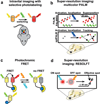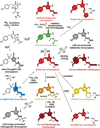Red fluorescent proteins: advanced imaging applications and future design
- PMID: 22851529
- PMCID: PMC4433748
- DOI: 10.1002/anie.201200408
Red fluorescent proteins: advanced imaging applications and future design
Abstract
In the past few years a large series of the advanced red-shifted fluorescent proteins (RFPs) has been developed. These enhanced RFPs provide new possibilities to study biological processes at the levels ranging from single molecules to whole organisms. Herein the relationship between the properties of the RFPs of different phenotypes and their applications to various imaging techniques are described. Existing and emerging imaging approaches are discussed for conventional RFPs, far-red FPs, RFPs with a large Stokes shift, fluorescent timers, irreversibly photoactivatable and reversibly photoswitchable RFPs. Advantages and limitations of specific RFPs for each technique are presented. Recent progress in understanding the chemical transformations of red chromophores allows the future RFP phenotypes and their respective novel imaging applications to be foreseen.
Copyright © 2012 WILEY-VCH Verlag GmbH & Co. KGaA, Weinheim.
Figures




References
-
- Subach FV, Malashkevich VN, Zencheck WD, Xiao H, Filonov GS, Almo SC, Verkhusha VV. Proc. Natl. Acad. Sci. USA. 2009;106:21097–21102. - PMC - PubMed
- Subach OM, Malashkevich VN, Zencheck WD, Morozova KS, Piatkevich KD, Almo SC, Verkhusha VV. Chem. Biol. 2010;17:333–341. - PMC - PubMed
- Mizuno H, Mal TK, Tong KI, Ando R, Furuta T, Ikura M, Miyawaki A. Mol. Cell. 2003;12:1051–1058. - PubMed
- Pakhomov AA, Martynov VI. Biochemistry. 2007;46:11528–11535. - PubMed
- Pletnev S, Subach FV, Dauter Z, Wlodawer A, Verkhusha VV. J. Am. Chem. Soc. 2010;132:2243–2253. - PMC - PubMed
- Remington SJ, Wachter RM, Yarbrough DK, Branchaud B, Anderson DC, Kallio K, Lukyanov KA. Biochemistry. 2005;44:202–212. - PubMed
- Shu X, Shaner NC, Yarbrough CA, Tsien RY, Remington SJ. Biochemistry. 2006;45:9639–9647. - PubMed
- Yampolsky IV, Remington SJ, Martynov VI, Potapov VK, Lukyanov S, Lukyanov KA. Biochemistry. 2005;44:5788–5793. - PubMed
- Piatkevich KD, Malashkevich VN, Almo SC, Verkhusha VV. J. Am. Chem. Soc. 2010;132:10762–10770. - PMC - PubMed
Publication types
MeSH terms
Substances
Grants and funding
LinkOut - more resources
Full Text Sources
Other Literature Sources
Miscellaneous

